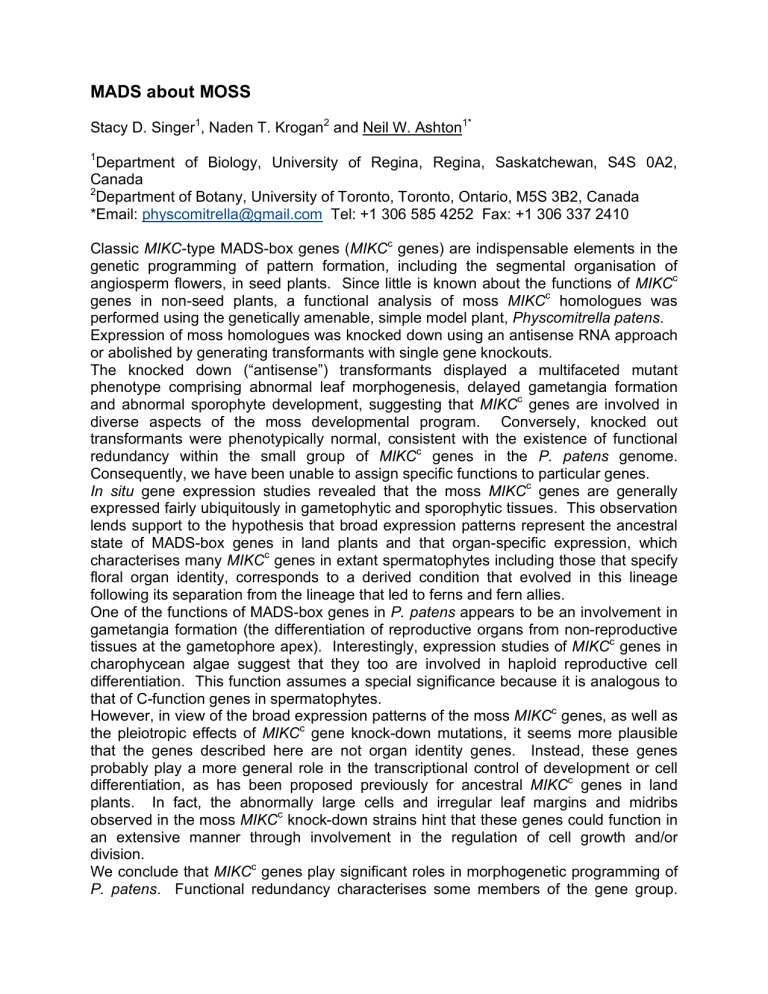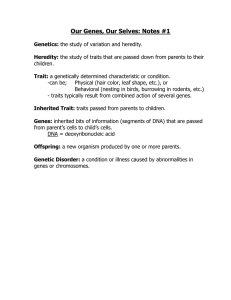MADS about MOSS
advertisement

MADS about MOSS Stacy D. Singer1, Naden T. Krogan2 and Neil W. Ashton1* 1 Department of Biology, University of Regina, Regina, Saskatchewan, S4S 0A2, Canada 2 Department of Botany, University of Toronto, Toronto, Ontario, M5S 3B2, Canada *Email: physcomitrella@gmail.com Tel: +1 306 585 4252 Fax: +1 306 337 2410 Classic MIKC-type MADS-box genes (MIKCc genes) are indispensable elements in the genetic programming of pattern formation, including the segmental organisation of angiosperm flowers, in seed plants. Since little is known about the functions of MIKCc genes in non-seed plants, a functional analysis of moss MIKCc homologues was performed using the genetically amenable, simple model plant, Physcomitrella patens. Expression of moss homologues was knocked down using an antisense RNA approach or abolished by generating transformants with single gene knockouts. The knocked down (“antisense”) transformants displayed a multifaceted mutant phenotype comprising abnormal leaf morphogenesis, delayed gametangia formation and abnormal sporophyte development, suggesting that MIKCc genes are involved in diverse aspects of the moss developmental program. Conversely, knocked out transformants were phenotypically normal, consistent with the existence of functional redundancy within the small group of MIKCc genes in the P. patens genome. Consequently, we have been unable to assign specific functions to particular genes. In situ gene expression studies revealed that the moss MIKCc genes are generally expressed fairly ubiquitously in gametophytic and sporophytic tissues. This observation lends support to the hypothesis that broad expression patterns represent the ancestral state of MADS-box genes in land plants and that organ-specific expression, which characterises many MIKCc genes in extant spermatophytes including those that specify floral organ identity, corresponds to a derived condition that evolved in this lineage following its separation from the lineage that led to ferns and fern allies. One of the functions of MADS-box genes in P. patens appears to be an involvement in gametangia formation (the differentiation of reproductive organs from non-reproductive tissues at the gametophore apex). Interestingly, expression studies of MIKCc genes in charophycean algae suggest that they too are involved in haploid reproductive cell differentiation. This function assumes a special significance because it is analogous to that of C-function genes in spermatophytes. However, in view of the broad expression patterns of the moss MIKCc genes, as well as the pleiotropic effects of MIKCc gene knock-down mutations, it seems more plausible that the genes described here are not organ identity genes. Instead, these genes probably play a more general role in the transcriptional control of development or cell differentiation, as has been proposed previously for ancestral MIKCc genes in land plants. In fact, the abnormally large cells and irregular leaf margins and midribs observed in the moss MIKCc knock-down strains hint that these genes could function in an extensive manner through involvement in the regulation of cell growth and/or division. We conclude that MIKCc genes play significant roles in morphogenetic programming of P. patens. Functional redundancy characterises some members of the gene group. Our findings provide clues concerning the ancestral roles of at least some MIKCc genes that may be represented in the genomes of diverse extant plant taxa.







